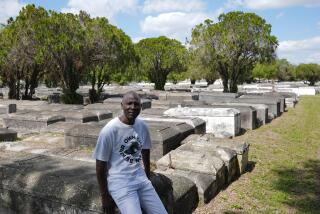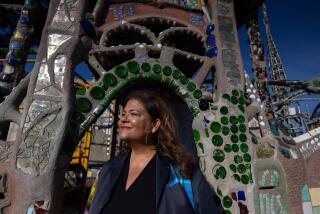‘Gone With the Wind’ Race Issues Still Buffet Atlanta
ATLANTA — Well, somebody had to speak the truth, and the mayor decided to do it. He stood Friday in the shade of the veranda looking out on a pride of smiling white and black faces, all come to pay tribute to The Woman Who Put Atlanta on the Map.
The governor was there. Author Tom Wolfe was there. Even relatives of the great lady herself were there, shivering slightly in the morning breeze as they awaited the official unveiling of the restored apartment building Margaret Mitchell affectionately called The Dump, the modest home in which she wrote most of “Gone With the Wind.”
Speakers praised Mitchell’s generosity, her altruism, her social commitment. Inside the house, a videotaped presentation told how she secretly paid for the education of 50 black doctors and worked to integrate the police department.
But so far, no one had spoken of the book itself, that living, breathing organism that is second only to the Bible in sales. So the mayor took it upon himself. Speaking quietly, he cut quickly to the heart of the matter--in and out, with surgical precision.
“It is true,” Bill Campbell began, “that, as a writer, she was guilty of using stereotypical images of African Americans.” There. Nothing too harsh. Just the truth from a black reader. “That is never acceptable--then or now.”
But, lest any Mitchell partisans take offense--they had come to praise her, after all, not bury her in scorn--Campbell quickly added: “She practiced tolerance and reached out to black Atlanta at a time when the city was split by color lines.”
And that was true too. The reality of Margaret Mitchell, like the reality of the South she wrote about, is more complex than people often give them credit.
*
Some of that complexity was on view Friday: In this mostly black city--a city too busy to hate and too forward-looking to have much patience for history--an interracial gathering was celebrating the spot where a renowned book was written, a book both praised and vilified for its treatment of history and race.
“One has to remember to judge the work in the context of its time,” Mary Rose Taylor, who spearheaded the building’s renovation, cautioned earlier in the week. Mitchell wrote “Gone With the Wind” in the 1920s and early 1930s, when there were still people alive who remembered the Civil War and its aftermath. The genesis of the book was the stories she had heard from her elders while growing up, as they sat in the parlor “refighting the Civil War,” Taylor said.
The color line was so rigid in Mitchell’s day that when the stars of the acclaimed movie adaptation came to Atlanta for the premiere in 1939, Butterfly McQueen and Academy Award winner Hattie McDaniel, who portrayed slaves, could not sleep in the same hotel as Clark Gable and Vivien Leigh.
But even considering the time in which Mitchell wrote, it’s hard to believe that the writer who described a beloved slave as having a “kind black face sad with the uncomprehending sadness of a monkey’s face” and who wrote black dialect so thick it’s hard to read (“Yes’m, dey keeps guns an’ sech lak dar. No’m, dem air ain’ sto’s, dey’s blockade awfisses”) was the same socially enlightened woman who spent much of her life helping people of all races.
*
The book offends so many people so deeply that when the now-restored apartment building where Mitchell lived from 1925 to 1932 was burned down twice while undergoing renovation, people assumed the arsonists opposed the attempt to commemorate her. Taylor believes, though, that the fires were set for commercial reasons, perhaps by people who had designs on the valuable real estate.
Taylor said she also faced difficulty raising funds to restore the house because of the indifference of many whites. Mitchell was a private person who lived a bohemian lifestyle that offended some people. “There are many of the old Atlanta whites who are still alive today,” she said, “and they don’t forget.”
After the first arson in 1994, the Daimler-Benz Corp.--which is dedicating an automobile manufacturing plant in Alabama next week and wants to strengthen ties to the region--donated $5 million for the renovation. When the house was set afire again last year, much of the money that had been earmarked for exhibits was diverted for the second restoration. As a result, the house will open to the public today with temporary exhibits.
Despite the controversy and indifference, Taylor’s 10-year crusade to restore the house has been supported by three black mayoral administrations, largely because of the tourism potential. And one of the people who spoke Friday in praise of Mitchell was Dr. Otis Smith, co-chairman of the restoration effort, and one of the medical students Mitchell put through school.
“She’s responsible for my being a physician,” said Smith, 71, a former chairman of the local NAACP branch and the first licensed black pediatrician in Georgia. Smith had been close to dropping out of the Morehouse University Medical School when an anonymous donor paid his tuition. He didn’t find out it was Mitchell until 35 years later.
Details of the arrangement, which were briefly mentioned in the autobiography of former Morehouse President Benjamin Mays, only became public two years ago, when a book was published about Mitchell’s long friendship with Mays. She decided to put medical students through the all-black school, she said in a letter to him in 1946, because she recognized the South’s “desperate need” for black doctors. “Georgia is a huge state and is poor,” she wrote. “We are poorer in Negro doctors, I am sure, than almost any other state.”
“She did it all behind the scenes,” Taylor said. “If her good works had become public knowledge, especially in the area of building bridges between blacks and whites, it would’ve been so highly controversial that it wouldn’t have happened.”
Taylor said Mitchell’s racial consciousness, like those of other open-minded whites of her era, evolved over time. But she scandalized white society early in life; the Junior League rejected her as a member in 1920 in part because she had done charity work in the black wards at a local hospital.
Mitchell, who died in 1949, began the book while holed up with arthritis in the two-room apartment she shared with her husband. When she finally turned it in to her publisher, Gov. Zell Miller noted, the manuscript stood five feet tall. She had written as many as 60 drafts of some chapters.
Miller grew up only two blocks from Mitchell’s apartment, in the same Midtown community. In those days, Peachtree Street was lined with grand houses, apartment buildings, stores and movie theaters. It really was a community.
Today, the apartment building sits surrounded by new skyscrapers and empty park land. The rich texture of life is no more. The apartment building, built in 1891, is one of the two oldest buildings still standing on the street.
“Gone With the Wind,” which was awarded the Pulitzer Prize in 1937, is often dismissed today as a nostalgic paean to the Lost Cause of the Confederacy. Taylor insists, though, that the true subject was patriotism. That is the reason why the book has been so popular in every developed war-torn country in the world, she said.
Wolfe, the keynote speaker at the dedication, said the reputations of great authors tend to fluctuate over the decades. By the early 1950s, he said, the critical opinion of “Gone With the Wind” had hit rock bottom. No doubt influenced by the movie, people now saw it as a nostalgic, rose-colored look back at a mythic South. “But she considered “Gone With the Wind” a book of radical revisionism,” he said, praising Mitchell’s careful delineation of the Southern class structure.
In his own estimation, the journalist and novelist said he considers the book he read for the first time only last spring, to be “one of the great tours de force of literary history.”
“I think the horror of war, as told through the eyes of women, was done more powerfully than it has ever been done,” Wolfe said.
More to Read
Sign up for our Book Club newsletter
Get the latest news, events and more from the Los Angeles Times Book Club, and help us get L.A. reading and talking.
You may occasionally receive promotional content from the Los Angeles Times.






